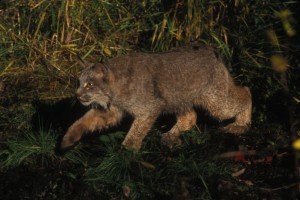 Trappers in the northern forests of the Lower 48 can breathe a collective sigh of relief tonight. After more than a decade of political struggle, it appears that the Canada lynx is finally headed down the path toward delisting, and relinquished Federal control over the species’ management.
Trappers in the northern forests of the Lower 48 can breathe a collective sigh of relief tonight. After more than a decade of political struggle, it appears that the Canada lynx is finally headed down the path toward delisting, and relinquished Federal control over the species’ management.
Here’s the release:
Conservation partnerships have helped protect this elusive cat across its range in the lower 48January 11, 2018
Contact(s):
Meagan Racey, 413-253-8558; Meagan_racey@fws.gov
Jennifer Strickland, 303-236-4574; Jennifer_strickland@fws.gov
Credit: USFWS/Gillian Racine
DENVER – The U.S. Fish and Wildlife Service (Service) is announcing the completion of a scientific review of the Canada lynx in the contiguous United States. The review concludes that the Canada lynx may no longer warrant protection under the Endangered Species Act (ESA) and should be considered for delisting due to recovery. This recommendation is the result of an extensive review of the best available scientific information and almost 20 years of working in partnership with state, federal, tribal, industry and other land managers on the conservation of this species. As a result of this status review, the Service will begin development of a proposed rule to delist the species.
“Working lands can go hand in hand with wildlife conservation in New England,” said Wendi Weber, the Service’s Northeast Regional Director. “Maine has the lower 48’s largest lynx population, and it is thanks to the strong collaboration among the state, the Maine Forest Products Council, private landowners, tribes, and conservation organizations that has advanced research, supported a strong economy and secured a forested future for the Canada lynx.”
The recommendation was informed by a recently completed, peer-reviewed Species Status Assessment for the lynx, which compiled and evaluated the best available scientific information on the historical, current and possible future conditions for the Canada lynx. Over a two-year process, the Service worked closely with federal, state and academic subject matter experts to evaluate relevant scientific information on snowshoe hare population dynamics, climate change, forest ecology and other issues. Although climate change remains an important factor for the conservation of the Canada lynx, neither the Service nor the experts we consulted conclude that the lynx is at risk of extinction from climate change within the foreseeable future.
The Canada lynx was listed as threatened in 2000 largely due to a lack of regulatory mechanisms on federal public lands, which is where a majority of the habitat for Canada lynx was believed to be located in the lower 48 states. Since receiving ESA protection, federal land managers throughout the lynx’s range have formally amended their management plans and implemented conservation measures to conserve the species. For example, all U.S. Forest Service land management plans in the Rocky Mountain region have been amended to include conservation measures for the Canada lynx. In addition, in Maine, private landowners have voluntarily supported working woodland easements that protect nearly 2.5 million acres of forest, benefitting the Canada lynx and other species.
“Through the stewardship of our partners such as the Maine Forest Products Council and many other private landowners, the population in Maine is growing and expanding,” said Chandler Woodcock, Commissioner, Maine Department of Inland Fisheries and Wildlife. “Not only are lynx found in more places, but signs of lynx are found more frequently during our surveys. And the research conducted by our biologists in conjunction with the USFWS showed modern forest management practices are compatible with lynx conservation.”
Maine Forest Products Council Executive Director Patrick Strauch added, “Maine’s forestland owners are proud to share in the success of the team of biologist from the U.S. Fish and Wildlife Service and Maine Department of Inland Fisheries and Wildlife that can demonstrate a healthy and vigorous population of Canada lynx in Maine.”
A cousin of the more common bobcat, the Canada lynx is similar in size but can be distinguished by its black-tipped tail, long tufts of black hair at the tips of its ears, and long legs with large, furry paws for hunting snowshoe hares in deep snow. In the contiguous U.S., Canada lynx populations are found in Maine, northeastern Minnesota, northwestern Montana, northeastern Idaho, north-central Washington and western Colorado.
Providing the Canada lynx protection under the ESA also prompted an increase in scientific understanding of lynx biology. Research, monitoring and conservation efforts conducted by state and federal agencies, tribes and academic institutions, helped refine biologists’ understanding of habitat needs, distributions, population characteristics and potential stressors.
In Maine beginning in 1999, the Department of Inland Fisheries and Wildlife (IFW) began a 12-year telemetry study in northern Aroostook county to assess lynx population status, survival and reproductive rates, and behavior. Information gathered from this study was instrumental in providing information on lynx biology, habitat needs, range, and the ability of Maine’s lynx population to expand. IFW continues to track radio-collared Canada lynx and is entering the third year of a three-year track survey. Preliminary results from the current survey effort show that the lynx are occupying a greater percentage of the available habitat in Maine.
“After nearly 2 decades of monitoring and research, Maine’s lynx population continues to grow in response to an abundance of forested habitat and prey,” said IFW lynx biologist Jen Vashon. “We are committed to continued protection and monitoring of lynx in Maine, and sharing information with private forest managers.”
Given the outcome of this analysis, the Service will not at this time be completing a recovery plan for the Canada lynx. Today’s recommendation does not remove or negate the Endangered Species Act protections currently in place for the Canada lynx. To delist a species, the Service must follow a process similar to what is used in considering whether to list species. The next step is for the Service to publish a proposed rule in the Federal Register, receive public comments, review and analyze those comments, conduct a peer review, and then announce a final decision.
Maine trappers have been under constant attack by animal rights groups, who mounted numerous lawsuits under the ESA over the years claiming the state wasn’t doing its job to prevent incidental take of lynx by trappers. These various suits resulted in a virtual makeover of Maine’s trapping laws, which has made it difficult for many trappers to harvest furbearers effectively and efficiently.
The potential for Canada lynx delisting is incredibly encouraging. I never thought I’d see the day. It’s been a long and difficult journey for Maine trappers, and was looking like trappers in other lynx states like Minnesota, Montana, Wyoming and Utah could have faced similar restrictions. Instead, we may be headed back to a place where sound wildlife management decisions are based on biology more than on politics.
Stay tuned to the Trapping Today Podcast for more on this issue. I’ll cover some of the background behind the lynx delisting, court battles and other drama in a future episode. There’s too much there to type! Till then, enjoy the good news, and get ready to provide written comments to the Feds when the delisting process gets underway. We’ll need all the support we can get!


Leave a Reply